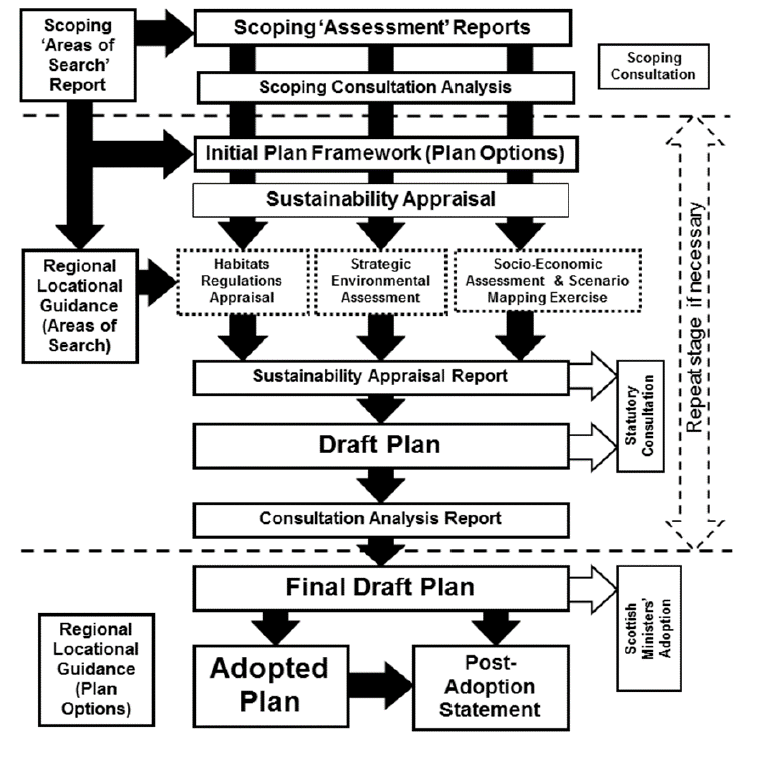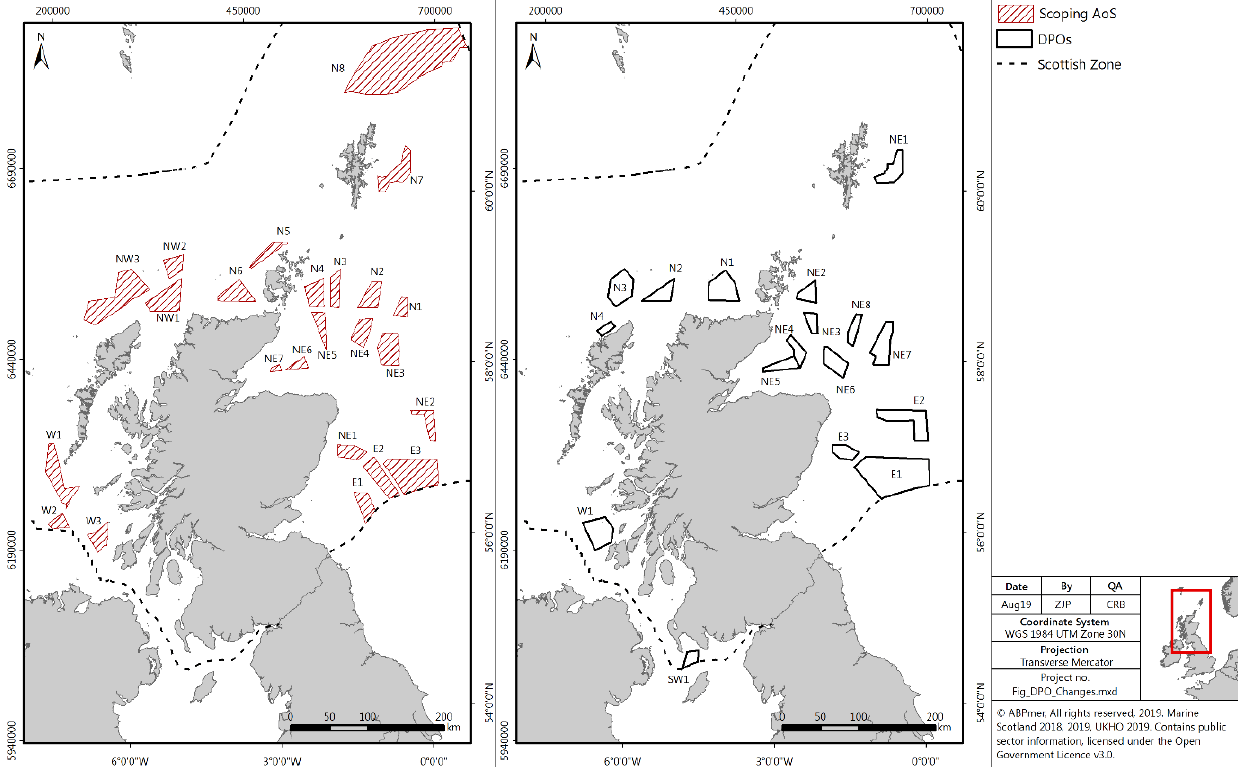Offshore wind energy: draft sectoral marine plan
The Plan aims to identify the most sustainable plan options for the future development of commercial-scale offshore wind energy in Scotland.
2. Plan development process
The sectoral marine planning process (as shown in Figure 5) is an iterative process, informed through stakeholder engagement and evidence from the related social, economic and environmental assessments. All of the information and consultation feedback gathered since the initial Areas of Search were identified in early 2018 has been used to support the Scottish Ministers in identifying DPOs to progress to the next phase of the plan process.
The DPOs have emerged through an examination of spatial data considerations in addition to advice and other related information provided by members of the Steering Groups, as well as stakeholders.

Figure 5 Sectoral Marine Plan for Offshore Wind Energy Development Process
The key stages of the planning process in relation to the identification of the Draft Plan Options are:
1. Opportunity and Constraint Analysis – Iteration 1
2. Opportunity and Constraint Analysis – Iteration 2 - Single Issue Constraint Analysis
3. Scoping Consultation
4. Opportunity and Constraint Analysis – Iteration 3
5. Identification of Draft Plan Options
6. Next Steps
1. Opportunity and Constraint Analysis – Iteration 1
The identification of initial Areas of Search ("AoS") was carried out through the use of an Opportunity and Constraint ("O&C") analysis.[14] It built upon previous work carried out by Marine Scotland Science ("MSS") in 2011[15] and the production of draft Regional Locational Guidance for potential deep water floating offshore wind test sites in 2014.[16] The analysis was iterative, so updates could be incorporated as required in order to reflect stakeholder feedback.
Full details of the O&C analysis can be found in the AoS scoping report published for consultation in 2018.[17] The O&C analysis sought to identify areas of opportunity for the future development of offshore wind, whilst also identifying areas that minimised potential negative impacts to the environment, other sectors and users of the sea. This analysis was completed through the use of GIS and numerous spatial data resources.
2. Opportunity and Constraint Analysis – Iteration 2
Sectoral engagement workshops were held in spring 2018. The AoS were then refined with consideration to specific spatial issues and feedback from the workshops.
This refinement process identified a range of distinct AoS (see Figure 6). As the draft Plan is technology neutral, no commercial or technology specific information was used in this refinement process.

Figure 6 Evolution of Areas of Search to Draft Plan Options
3. Scoping Consultation – Screening and Scoping Reports
Scottish Ministers then consulted on the screening and scoping stages of the Plan process during June and July 2018. Screening and scoping reports were prepared and published online for the SEA, HRA and SEIA alongside the AoS scoping study.
4. Opportunity and Constraint Analysis – Iteration 3
Iteration 3 of the O&C analysis was undertaken, which considered the responses received during the Scoping Consultation, for more details see the Consultation Analysis Report.[18]
The AoS were refined with consideration to the outputs of the Iteration 3 O&C Analysis. As a result, certain AoS were either removed or refined to avoid/incorporate certain areas of Scottish Waters.
This stage also considered the areas of seabed proposed by stakeholders via the scoping consultation. A number of the areas proposed overlapped with existing AoS, while others overlapped with areas with higher levels of constraint or entirely new areas.
Upon review of the above information, a number of areas were identified to move forward in the plan process. Accordingly, some additional areas were included at this stage, where there was significant stakeholder interest, but also increased constraint. The Sustainability Appraisal stage assessed these new areas in greater detail.
5. Identification of Draft Plan Options
The 22 revised AoS were made available to the Sectoral Marine Plan Project Board and two Project Steering Groups for consideration and comment.[19]
Responses from both the Board and Steering Groups, together with the outputs of the initial assessments, werewas presented to Scottish Ministers to inform their decision on which AoS should progress to the Sustainability Appraisal for more detailed assessment. 17 revised AoS were selected as DPOs.
6. Next Steps
Following the statutory consultation, the responses received will be subject to consultation analysis. This analysis will be considered by Scottish Ministers' and inform their decision on which Options to take forward in the final Plan.
It should be noted that if significant changes are required as a result of the consultation feedback, further assessment and consultation may be required prior to adoption and publication of the final Plan. The Post Adoption Statement (to be published with the final Plan) will detail any changes made to the Plan as a result of consultation feedback.
Contact
Email: drew.milne@gov.scot
There is a problem
Thanks for your feedback